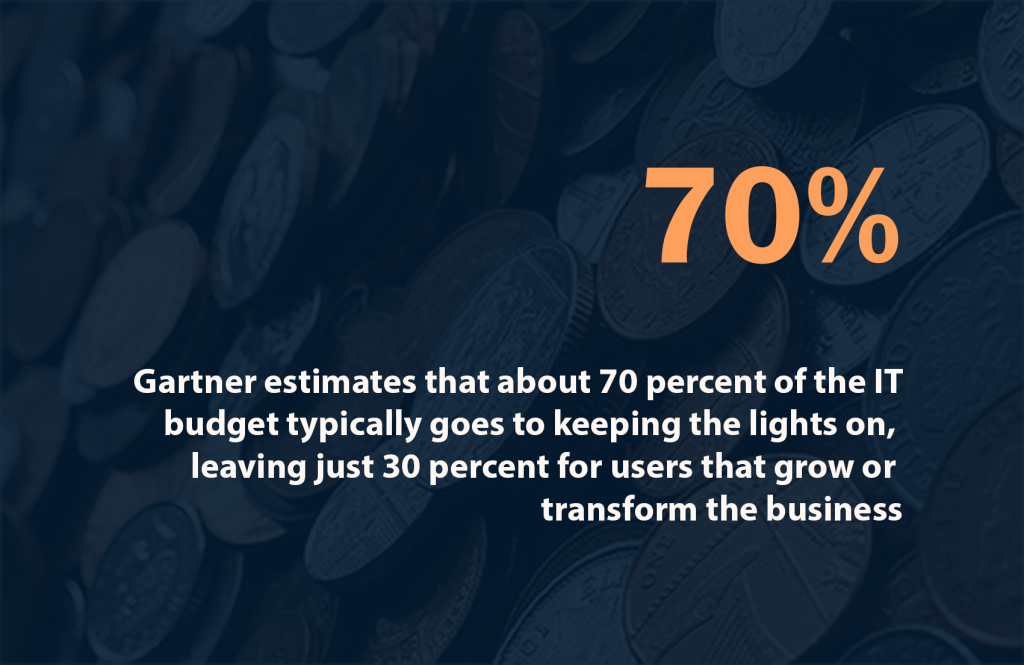AuraQ has vast experience helping organisations find the gaps that can be filled to enhance their business. This could be to improve efficiency, integrate legacy systems or deliver new portals and strategic applications to create competitive advantage. Contact us to request a free, no obligation Gap Analysis.
Why low-code IS a matter for the board
It all starts with corporate objectives…Before I speak to customers about their technology requirements, my first question is: “What are you trying to achieve as a company?” A quick look at their annual report and the evidence is clear to see – since corporate strategic objectives are set by the board and published to the markets. Almost without exception, these objectives will be aligned to growing revenue and reducing cost. Being more specific, four commonly stated areas are:
- Growth of revenue – via acquisition, new channels, new markets, new products
- Improved customer experience – via digital services, self-service, 24/7 availability
- Streamlining operations – simplification and automation to reduce the cost to serve
- Reduction of risk – improving brand trust and reducing cost of incidents
In increasingly competitive markets, these objectives form part of the mission of the company and are vital to its future. Fickle customers will go elsewhere if they can make their purchase online at midnight, while complex internal operations add costly overheads as well as impacting customer experience and overall margins. Clear targets are set and published (e.g., reduce operational cost by £500m), and these must cascade from the board through the business units to departmental and operational leads who share accountability (and have their own targets). So, when managers are tasked with reducing costs or growing sales, they see technology as a solution. It’s clear that initiatives to streamline their processes, to automate tasks and to offer new applications to customers (B2B and B2C) are obvious routes to achieving their targets. Inevitably this drives a pipeline of demands from the business and speed to market is critical.
The challenge for IT
While the business is busy generating ideas and a pipeline of demands, IT usually has a dilemma. It is faced with a continuous stream of requirements, but not just from the business needing new capabilities. Typically, 70% or more of the IT budget is spent solely on “keeping the lights on” (Gartner suggests 70%, while Forrester research says it’s around 72%). Both numbers suggest that maintaining existing technology is always a significant budgetary focus. With complex system architectures that have evolved over many years, IT spend is prioritised towards mission critical systems. And they need to be maintained. Core systems that are central to business operations are typically inflexible and hard to change. They also cannot be compromised and keeping these up to date, secure and resilient is priority. Brand reputation relies on stability, and good governance and quality controls are fundamental to this. This focus leaves little capacity, time, and budget for innovation.
The result is a marked gap between the demand for new business services and the ability of IT to deliver. The business needs speed to market – but also cannot afford high risk, core application change programmes. Enhancements to these systems can take months or even years, and often business requirements have evolved long before upgrades can be implemented. Ultimately, deploying new services and products on these platforms is not an option. With limited IT resources to support innovation, the business looks outside of IT for help. This is when departmental projects begin to deploy “Shadow IT” or “End User Computing” solutions. It’s understandable – when leaders are incentivised with saving costs or implementing a new service, they will look for alternative and creative ways to achieve their goals. The issue with this is that such solutions fall outside the IT domain and are usually supported by the business or the vendor of the application. IT may have no visibility or influence over these selections, even though they underpin critical products and services.
The low-code approach
We often see business stakeholders turn to low-code platforms to meet their needs. Low-code technologies are being used by organisations to fulfil growing demands for speed of application delivery and to deliver highly customised automation workflows. This is a rapidly growing trend with analysts predicting this year a 19.6% rise in adoption from 2022 (Gartner). Quick to deliver, these cloud-based applications are easy for the business to understand and engage with and often are a revelation that enables business heads to meet their objectives. However, it’s all too easy for such applications to become part of the morass of “Shadow IT”. While applications deliver impressive and tangible business value, as a purely departmental solution organisations are missing a much bigger opportunity for low-code to meet its true potential – closing the gap between business demand and IT’s ability to supply. If the enterprise goal is to reduce cost by £500m, the departmental savings are simply a slice of that pie – so what about the rest?
Bridging the gap
Where traditional solutions can take months or years to deliver, low-code solutions are typically delivered in a matter of weeks by small collaborative teams leveraging skills across both the business and IT. Development effort is estimated to be between 10-25% of that required for traditional code-based solutions. It seems obvious that having a low-code capability within IT is a game changer. What if IT could deliver 4x faster with fewer resources, in collaboration with the business, and with all of the corporate standard governance and controls that the organisation requires? Bringing low-code technology into the arsenal of IT is a potent weapon. It reduces shadow IT and enables business agility, while liberating demands for new products and services from the classic obstacle of unacceptable lead times. All of this points to the need for the establishment of low-code delivery capability, in the heart of IT, as a strategic initiative that aligns directly to corporate strategic goals.
Why low-code is a matter for the board
Establishing any new capability requires investment. Like any other business function, it needs to be properly designed and strong foundations put in place before it can reach full “run” potential. This includes selecting the right technology platform; defining governance, controls, and standards for the programme; creating a centre of excellence to support delivery of applications; engaging with the right delivery partners to enable scalability. All of which brings us back full circle to the IT budget challenge. With limited resources for innovation, it’s hard to ringfence funds from the IT budget for such a programme.
Put simply, low-code solutions can deliver at pace against strategic corporate objectives, enabling the delivery of new products and services, new digital channels for customers, streamlining and automating key processes and reducing risk across the business. While departmental usages of the technology will have proven viability and demonstrated tangible business value for those solutions, as mentioned already – these are just chipping away at the wider corporate goals. Establishing the ability to deliver such solutions enterprise-wide opens the door to unlocking business value at a corporate scale. So, investment is needed – and that’s a matter for the board!










